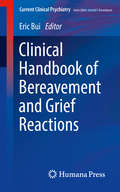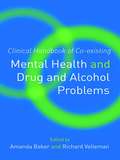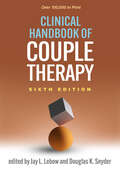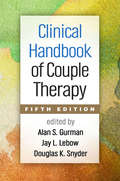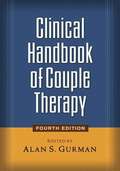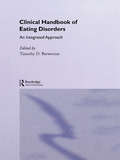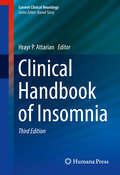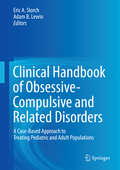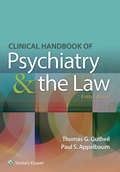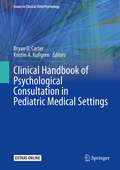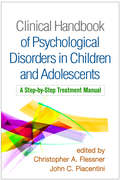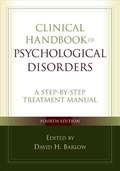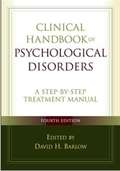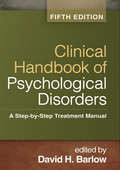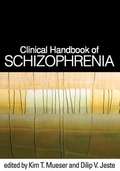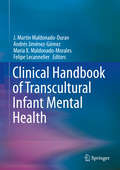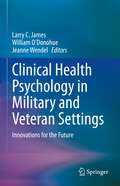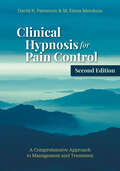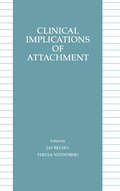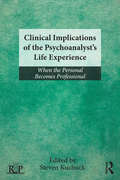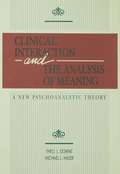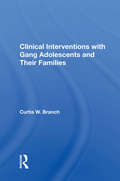- Table View
- List View
Clinical Handbook of Bereavement and Grief Reactions (Current Clinical Psychiatry)
by Eric BuiThe text is designed to present a state-of the-art approach to the assessment and management of bereavement-related psychopathology. Written by experts in the field, book addresses the elevated urgency of bereavement from its former classification as an area for more research to its current DSM-5 status as a major depressive disorder, calling for greater recognition of bereavement-related psychopathology. The text introduces and reviews the theoretical background underlying bereavement-related psychopathology, addresses the issues faced by clinicians who assess bereaved individuals in different specific contexts, and reviews the management and different treatment approaches for individuals with grief reactions that include both medicated and non-medicated approaches. Clinical Handbook of Bereavement and Grief Reactions is a valuable resource for psychiatrists, psychologists, students, counselors, psychiatric nurses, social workers, and all medical professionals working with patients struggling with bereavement and grief reactions.
Clinical Handbook of Co-existing Mental Health and Drug and Alcohol Problems
by Richard Velleman Amanda BakerCo-existing mental health and drug and alcohol problems occur frequently in primary care and clinical settings. Despite this, health professionals rarely receive training in how to detect, assess and formulate interventions for co-existing problems and few clinical guidelines exist. This Handbook provides an exciting and highly useful addition to this area. Leading clinicians from the UK, the US and Australia provide practical descriptions of assessments and interventions for co-existing problems. These will enable professionals working with co-existing problems to understand best practice and ensure that people with co-existing problems receive optimal treatment. A range of overarching approaches are covered, including: • working within a cognitive behavioural framework;• provision of consultation-liaison services, training and supervision;• individual, group and family interventions; and• working with rurally isolated populations. The contributors also provide detailed descriptions of assessments and treatments for a range of disorders when accompanied by drug and alcohol problems, including anxiety, depression, schizophrenia, bipolar disorder and learning difficulties. The Clinical Handbook of Co-existing Mental Health and Drug and Alcohol Problems will enhance clinicians’ confidence in working with people with co-existing problems. It will prove a valuable resource for all psychologists, psychiatrists, counsellors, social workers and all those working in both primary and secondary care health settings.
Clinical Handbook of Couple Therapy
by Jay L. Lebow Douglas K. SnyderNow in a significantly revised sixth edition with 70% new material, this comprehensive handbook has introduced tens of thousands of practitioners and students to the leading forms of couple therapy practiced today. Prominent experts present effective ways to reduce couple distress, improve overall relationship satisfaction, and address specific relational or individual problems. Chapters on major approaches follow a consistent format to help readers easily grasp each model's history, theoretical underpinnings, evidence base, and clinical techniques. Chapters on applications provide practical guidance for working with particular populations (such as stepfamily couples and LGBT couples) and clinical problems (such as intimate partner violence, infidelity, and various psychological disorders). Instructive case examples are woven throughout. New to This Edition *Chapters on additional clinical approaches: acceptance and commitment therapy, mentalization-based therapy, intergenerational therapy, socioculturally attuned therapy, and the therapeutic palette approach. *Chapters on sexuality, older adult couples, and parents of youth with disruptive behavior problems. *Chapters on assessment and common factors in couple therapy. *Chapters on cutting-edge special topics: relationship enhancement, telehealth interventions, and ethical issues in couple therapy.
Clinical Handbook of Couple Therapy, Fifth Edition
by Alan S. Gurman Jay L. Lebow Douglas K. SnyderRegarded as the authoritative reference and text, this handbook presents the most effective, widely studied approaches to couple therapy. The distinguished coeditors bring together other leading experts, most of whom developed the approaches they describe. Adhering closely to a uniform structure to facilitate study and comparison, chapters cover the history, theoretical and empirical underpinnings, and techniques of each model. The volume also describes cutting-edge applications for particular relationship contexts (such as blended families, LGBT couples, and separated couples) and clinical problems (such as partner aggression, psychological disorders, and medical issues). New to This Edition *Chapters on interpersonal neurobiology and intercultural relationships. *Chapters on couple therapy for PTSD, functional analytic couple therapy, and the integrative problem-centered metaframeworks approach. *Many new authors; extensively revised with the latest theory and research. See also Clinical Casebook of Couple Therapy, edited by Alan S. Gurman, which presents in-depth illustrations of treatment.
Clinical Handbook of Couple Therapy, Fourth Edition
by Alan GurmanThis authoritative handbook provides a definitive overview of the theory and practice of couple therapy. Noted contributors--many of whom developed the approaches they describe--combine clear conceptual exposition with thorough descriptions of therapeutic techniques. In addition to presenting major couple therapy models in step-by-step detail, the book describes effective applications for particular populations and problems. Chapters adhere closely to a uniform structure to facilitate study and comparison, enhancing the book's utility as a reference and text. New to This Edition 11 new chapters. Numerous new and revised case examples. The latest data and clinical techniques. Expanded introductory chapter that reviews key concepts and themes. Up-to-date coverage of gender issues, lesbian and gay couples, and cultural diversity.
Clinical Handbook of Eating Disorders: An Integrated Approach (Medical Psychiatry Ser. #Vol. 26)
by Timothy D. BrewertonEmphasizing that accurate diagnosis is the foundation for effective treatment regimens, this reference reviews the most current research on the assessment, epidemiology, etiology, risk factors, neurodevelopment, course of illness, and various empirically-based evaluation and treatment approaches relating to eating disorders-studying disordered eati
Clinical Handbook of Insomnia (Current Clinical Neurology)
by Hrayr P. AttarianExpanding on the critical contributions of previous editions, this updated and comprehensive resource covers the latest diagnostic criteria of insomnia. The book is thematically divided into two parts. The first section consists of chapters on nomenclature, epidemiology, pathophysiology, diagnosis and differential diagnosis, complications and prognosis and treatment both pharmacological and behavioral. The second features chapters on insomnia in special populations, including ones on children and adolescents, cancer sufferers and survivors, in pregnancy, in menopausal women and in patients with neurological disorders and those with psychiatric illnesses. This third edition fills an important niche in the medical literature by addressing insomnia in its multiple forms, summarizes the findings published in different medical journals, and presents these to the practicing health care provider in an easily accessible format.
Clinical Handbook of Mindfulness
by Fabrizio DidonnaOver the last two decades, Eastern psychology has provided fertile ground for therapists, as a cornerstone, a component, or an adjunct of their work. In particular, research studies are identifying the Buddhist practice of mindfulness--a non-judgmental self-observation that promotes personal awareness--as a basis for effective interventions for a variety of disorders. The Clinical Handbook of Mindfulness is a clearly written, theory-to-practice guide to this powerful therapeutic approach (and related concepts in meditation, acceptance, and compassion) and its potential for treating a range of frequently encountered psychological problems. Key features of the Handbook: A neurobiological review of how mindfulness works. Strategies for engaging patients in practicing mindfulness. Tools and techniques for assessing mindfulness. Interventions for high-profile conditions, including depression, anxiety, trauma Special chapters on using mindfulness in oncology and chronic pain. Interventions specific to children and elders, Unique applications to inpatient settings. Issues in professional training. Appendix of exercises. The Clinical Handbook of Mindfulness includes the contributions of some of the most important authors and researchers in the field of mindfulness-based interventions. It will have wide appeal among clinicians, researchers, and scholars in mental health, and its potential for application makes it an excellent reference for students and trainees.
Clinical Handbook of Obsessive-Compulsive and Related Disorders: A Case-Based Approach to Treating Pediatric and Adult Populations
by Eric A. Storch Adam B. LewinThis handbook examines evidence-based treatment of obsessive-compulsive and related disorders for a broad clinical audience. Focusing on both children and adults with these conditions, it discusses various manifestations of OCD (e. g. , contamination, perfectionism), related conditions (e. g. , hoarding, trichotillomania, and Tourette syndrome), and cases with complicating factors. Chapters describe case specifics, offer assessment guidelines, and illustrate evidence-based psychotherapy. Case examples depict real-life complexities of presentation, notably in terms of comorbid conditions and hard-to-treat subpopulations. Topical areas addressed in the Handbook include: Phenomenology, assessment, and treatment of multiple types of OCD in adults and children. Treating "not just right experiences" in children with OCD. Treating obsessive compulsive disorder in very young children. Treatment of OCD comorbid with other disorders like depression and Autism Spectrum Disorder. Treatment of OCD when presenting with complicating factors like limited insight, extreme family accommodation, and poor motivation. The Clinical Handbook of Obsessive-Compulsive and Related Disorders is an essential resource for clinicians and professionals as well as researchers, and graduate students in clinical psychology, psychiatry, social work, counseling programs, pediatrics, public health, and related disciplines.
Clinical Handbook of Psychiatry and the Law
by Thomas G. Gutheil Paul S. AppelbaumWritten by two renowned leaders in the field, the much-anticipated fifth edition of Clinical Handbook of Psychiatry and the Law offers mental health professionals authoritative guidance on how today’s law affects clinical practice. Each chapter in this award-winning reference presents case examples of legal issues often seen in day-to-day practice; clearly explains the governing legal rules, their rationale, and their clinical impact; and offers concrete action guides to navigating clinicolegal dilemmas. It’s a must-have resource for anyone in the mental health field who needs an easy-to-read, practical handbook addressing both longstanding legal/ethical issues and crucial recent developments in the field.
Clinical Handbook of Psychological Consultation in Pediatric Medical Settings (Issues in Clinical Child Psychology)
by Bryan D. Carter Kristin A. KullgrenThis handbook examines pediatric consultation-liaison psychology in pediatric medical settings. It offers a brief history of pediatric psychologists’ delivery of consultation-liaison services. The handbook provides an overview of roles, models, and configurations of pediatric psychology practice in diverse inpatient and outpatient medical settings. Chapters discuss the most frequently seen major pediatric conditions encountered in consultation practice. Coverage includes evaluation, intervention, and treatment of each condition. Each clinical condition addresses the referral problem in the context of history and family dynamics. In addition, chapters address important aspects of the management of a consultation-liaison service and provide contextual issues in delivering evidence-based services in hospital and medical settings. Topics featured in this handbook include:The role of assessment in the often fast-paced medical environment.Modifications of approaches in the context of disorders of development.Consultation on pediatric gender identity.The presentation of child maltreatment in healthcare settings.The use of technological innovations in pediatric psychological consultation.Important ethical considerations in consultation-liaison practice. Clinical Handbook of Psychological Consultation in Pediatric Medical Settings is a must-have resource for clinicians and related professionals as well as researchers, professors, and graduate students in pediatric and clinical child and adolescent psychology, pediatrics, social work, developmental psychology, child and adolescent psychiatry, and related disciplines.
Clinical Handbook of Psychological Disorders in Children and Adolescents: A Step-by-Step Treatment Manual
by Christopher A. Flessner John C. PiacentiniBringing together leading authorities, this volume synthesizes the breadth of current research on child and adolescent treatment into a practical handbook for students and clinicians. The book was inspired by the preeminent work on adult disorders, Clinical Handbook of Psychological Disorders (now in its fifth edition). It provides a concise overview of the disorders most commonly encountered in clinical practice and details evidence-based treatment approaches, largely grounded in cognitive-behavioral therapy (CBT). Procedures for assessment, diagnosis, case formulation, intervention, and progress monitoring are illustrated with rich extended case examples, including session transcripts. The book addresses nuts-and-bolts issues such as how to set up each session, what to cover, and how to broach difficult topics with children and parents. See also Clinical Handbook of Psychological Disorders, Fifth Edition (on adults), edited by David H. Barlow.
Clinical Handbook of Psychological Disorders, Fourth Edition
by David BarlowWith over 75,000 copies sold, this clinical guide and widely adopted text presents authoritative guidelines for treating frequently encountered adult disorders. The Handbook is unique in its focus on evidence-based practice and its attention to the most pressing question asked by students and practitioners "How do I do it?" Leading clinical researchers provide essential background knowledge on each problem, describe the conceptual and empirical bases of their respective approaches, and illustrate the nuts and bolts of evidence-based assessment and intervention. New to This Edition Incorporates treatment innovations and new empirical findings. Additional treatment protocols behavioral activation for depression, psychological treatments for positive symptoms of schizophrenia, and unified approaches to emotional disorders and eating disorders.
Clinical Handbook of Psychological Disorders: A Step-by-Step Treatment Manual (4th edition)
by David H. BarlowThis clinical guide and widely adopted text provides students and practitioners with state-of-the-science guidelines for treating frequently encountered adult disorders. Contributors are leading clinical researchers who present essential background knowledge on each problem, describe the conceptual and empirical bases of their respective approaches, and detail the nuts and bolts of evidence-based assessment and intervention.
Clinical Handbook of Psychological Disorders: A Step-by-Step Treatment Manual (Fifth Edition)
by David H. BarlowThis clinical reference and widely adopted text is recognized as the premier guide to understanding and treating frequently encountered psychological disorders in adults. Showcasing evidence-based psychotherapy models, the volume addresses the most pressing question asked by students and practitioners--"How do I do it?" Leading authorities present state-of-the-art information on each clinical problem and explain the conceptual and empirical bases of their respective therapeutic approaches. Procedures for assessment, case formulation, treatment planning, and intervention are described in detail. Extended case examples with session transcripts illustrate each component of treatment.
Clinical Handbook of Psychological Disorders: A Step-by-Step Treatment Manual (Third Edition)
by David H. BarlowWritten primarily from a cognitive-behavioral perspective, this book describes treatment methods for various disorders.
Clinical Handbook of Schizophrenia
by Kim Mueser Dilip JesteReviewing the breadth of current knowledge on schizophrenia, this handbook provides clear, practical guidelines for effective assessment and treatment in diverse contexts. Leading authorities have contributed 61 concise chapters on all aspects of the disorder and its clinical management. In lieu of exhaustive literature reviews, each chapter summarizes the state of the science; highlights key points the busy practitioner needs to know; and lists recommended resources, including seminal research studies, invaluable clinical tools, and more. Comprehensive, authoritative, and timely, the volume will enable professionals in any setting to better understand and help their patients or clients with severe mental illness.
Clinical Handbook of Transcultural Infant Mental Health
by Felipe Lecannelier J. Martin Maldonado-Duran Andrés Jiménez-Gómez Maria X. Maldonado-MoralesThis handbook provides a review of relevant topics concerning the interface between culture and mental health, with a particular focus on child-rearing practices and transcultural issues in the perinatal period, infancy, and early childhood. It discusses how to work with infants and families from diverse backgrounds and addresses the most common issues that medical and mental health experts may encounter when working with individuals from other cultures. Chapters examine the considerable range of child-rearing strategies and how families from various cultural groups approach issues such as infant sleep, feeding practices, and care during pregnancy. In addition, chapters address conditions that are seen mostly within a particular sociocultural context and are “culture bound” syndromes or states. The handbook concludes with the editors’ recommendations for future research directions. Topics featured in this handbook include:Prejudice, discrimination, and stereotyping within the clinical field.Cultural responses to infant crying and irritability.Cultural issues in response to chronic conditions and malformations in infancy.The healthy immigrant effect.The use of folk and traditionally therapeutic remedies. The Clinical Handbook of Transcultural Infant Mental Health is an essential resource for researchers, clinicians and related professionals, and graduate students in infancy and early child development, child and school psychology, pediatrics, social work, obstetrics, and nursing.
Clinical Health Psychology in Military and Veteran Settings: Innovations for the Future
by Larry C. James William O’Donohue Jeanne WendelThis book will fill an important gap in literature covering the clinical health psychology applications affecting the military and veteran health care systems. The authors draw on a wealth of experience related to treatment of service members and veterans, implementation of innovative research programs within military settings, and analysis of health economics issues. Section I examines key economic challenges facing civilian, military and Veteran healthcare providers. Section II discusses innovative clinical health psychology applications in military hospitals and clinics from around the country, including comprehensive literature reviews and presenting novel clinical applications in military hospitals. This book is relevant for clinicians, policymakers and administrators working with military and veteran patients.
Clinical Hypnosis for Pain Control: A Comprehensive Approach to Management and Treatment
by David R. Patterson M. Elena MendozaThis comprehensive guide shows how integrating hypnosis with psychotherapy and mindful meditation can help clinicians treat patients who suffer from chronic and acute pain. David R. Patterson and M. Elena Mendoza present hypnotic analgesia as a viable alternative to psychopharmacological interventions for pain resulting from physical injuries, nerve damage, surgery, neurological problems, and other sources. They review research elucidating the neurophysiological and biopsychosocial roots of pain and provide clinical strategies that can be applied in a variety of settings. Patterson and Mendoza adopt a nuanced treatment model that deemphasizes pain reduction, which can be counterproductive, and focuses instead on adaptive pain management through cognitive restructuring. This second edition includes updated research findings and practice guidelines, including technological innovations like virtual reality hypnosis, and a new chapter on mindful meditation. The authors also add a step-by-step case example that walks readers through an integrative, eight-session process and brings the techniques described in this volume to life.
Clinical Implications of Attachment (Child Psychology Series)
by Jay Belsky Teresa NezworskiFirst published in 1987. This study records findings of a study group set up to explore a variety of issues related to attachment, including the predictive utility of Strange Situation assessments, the conditions under which insecurity is related to subsequent difficulties, the origins of individual differences in attachment security, and intervention strategies that might prove useful in ameliorating the developmental risks that appeared to be associated with insecure attachment relationships
Clinical Implications of the Psychoanalyst's Life Experience: When the Personal Becomes Professional (Relational Perspectives Book Series)
by Steven Kuchuck2015 Gradiva Award Winner Clinical Implications of the Psychoanalyst’s Life Experience explores how leaders in the fields of psychoanalysis and psychotherapy address the phenomena of the psychoanalyst’s personal life and psychology. In this edited book, each author describes pivotal childhood and adult life events and crises that have contributed to personality formation, personal and professional functioning, choices of theoretical positions, and clinical technique. By expanding psychoanalytic study beyond clinical theory and technique to include a more careful examination of the psychoanalyst’s life events and other subjective phenomena, readers will have an opportunity to focus on specific ways in which these events and crises affect the tenor of the therapist’s presence in the consulting room, and how these occurrences affect clinical choices. Chapters cover a broad range of topics including illness, adoption, sexual identity and experience, trauma, surviving the death of one’s own analyst, working during 9/11, cross cultural issues, growing up in a communist household, and other family dynamics. Throughout, Steven Kuchuck (ed) shows how contemporary psychoanalysis teaches that it is only by acknowledging the therapist’s life experience and resulting psychological makeup that analysts can be most effective in helping their patients. However, to date, few articles and fewer books have been entirely devoted to this topic. Clinical Implications of the Psychoanalyst’s Life Experience forges new ground in exploring these under-researched areas. It will be essential reading for practicing psychoanalysts, psychotherapists, psychologists, social workers, those working in other mental health fields and graduate students alike.
Clinical Interaction and the Analysis of Meaning: A New Psychoanalytic Theory
by Theo L. Dorpat Michael L. MillerClinical Interaction and the Analysis of Meaning evinces a therapeutic vitality all too rare in works of theory. Rather than fleeing from the insights of other disciplines, Dorpat and Miller discover in recent research confirmation of the possibilities of psychoanalytic treatment. In Section I, "Critique of Classical Theory," Dorpat proposes a radical revision of the notion of primary process consonant with contemporary cognitive science. Such a revised conception not only enlarges our understanding of the analytic process; it also provides analysis with a conceptual language that can articulate meaningful connections with a growing body of empirical research about the development and nature of human cognition. In Section II, "Interactional Theory," Miller reverses the direction of inquiry. He begins with the literature on cognitive development and functioning, and proceeds to mine it for concepts relevant to the clinical process. He shows how a revised understanding of the operation of cognition and affect can impart new meaning to basic clinical concepts such as resistance, transference, and level of psychopathology. In Section III, "Applications and Exemplifications," Dorpat concludes this exemplary collaboration by exploring select topics from the standpoint of his and Miller's new psychoanalytic theory. At the heart of the authors' endeavor it "meaning analysis," a concept that integrates an up-to-date model of human information processing with the traditional goals of psychoanalysis. The patient approaches the clinical encounter, they argue, with cognitive-affective schemas that are the accumulatice product of his life experience to date; the manifold meanings ascribed to the clinical interaction must be understood as the product of these schemas rather than as distortions deriving from unconscious, drive-related fantasies. The therapist's goal is to make the patient's meaning-making conscious and thus available for introspection.
Clinical Interventions With Gang Adolescents And Their Families
by Curtis W. BranchThis volume is bold and revolutionary, a clinically oriented primer for clinicians and others interested in the mental health functioning of gang youth and their families. Providing a well-integrated mixture of theory, clinical axioms, and practical ideas, the book offers invaluable information to clinicians, researchers, and program planners worki
Clinical Interventions in Systemic Couple and Family Therapy (European Family Therapy Association Series)
by Roberto Pereira Juan Luis LinaresThis timely update presents modern directions in systemic therapy practice with couples and families, focusing on clinical innovations from Italy, Portugal, and Spain. Top therapists discuss their breakthrough family work in treating familiar pathologies such as depression, borderline personality disorder, infidelity, and addictions, providing first-hand insight into meeting relational dysfunction with creativity and resourcefulness. The book applies novel conceptualizations and fresh techniques to complex situations including multi-problem families, involuntary clients, disability-related issues, anorexia, love and sex in aging, and family grief. From tapping into the strengths of siblingship to harnessing the therapeutic potential of the Internet, the book’s cases illustrate the rich variety of opportunities to improve client outcomes through systemic couple and family therapy.This practical guide: Demonstrates strategies for therapists to improve practiceExemplifies methods for reducing the gap between clinical theory and practiceIdentifies multiple dimensions of systems thinking in case formulation and therapyOffers new insights into treating classic and recent forms of psychopathologyProvides a representative picture of couple and family therapy in southern EuropeClinical Interventions in Systemic Couple and Family Therapy is of particular relevance to practitioners and clinicians working within couple and family therapy, and is also of interest to other professionals working in psychotherapy and professional mental health services.
